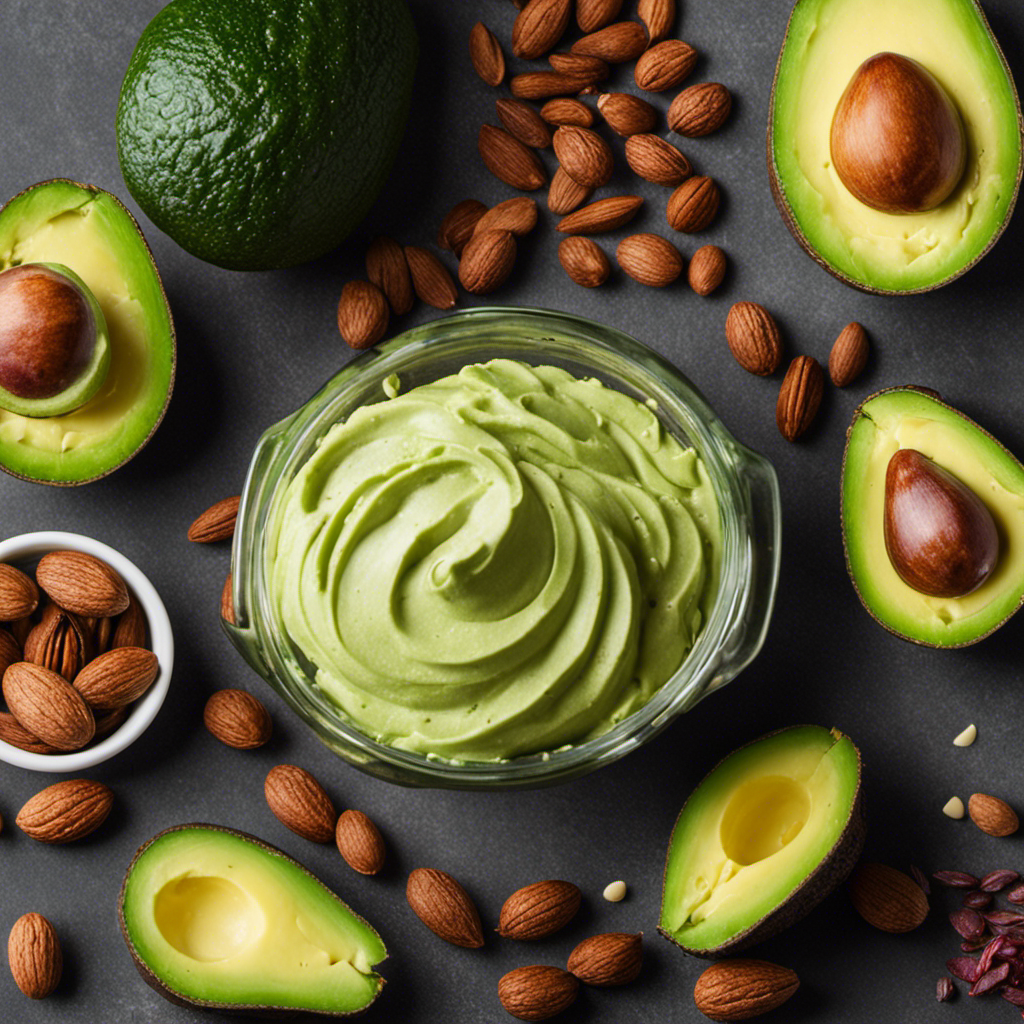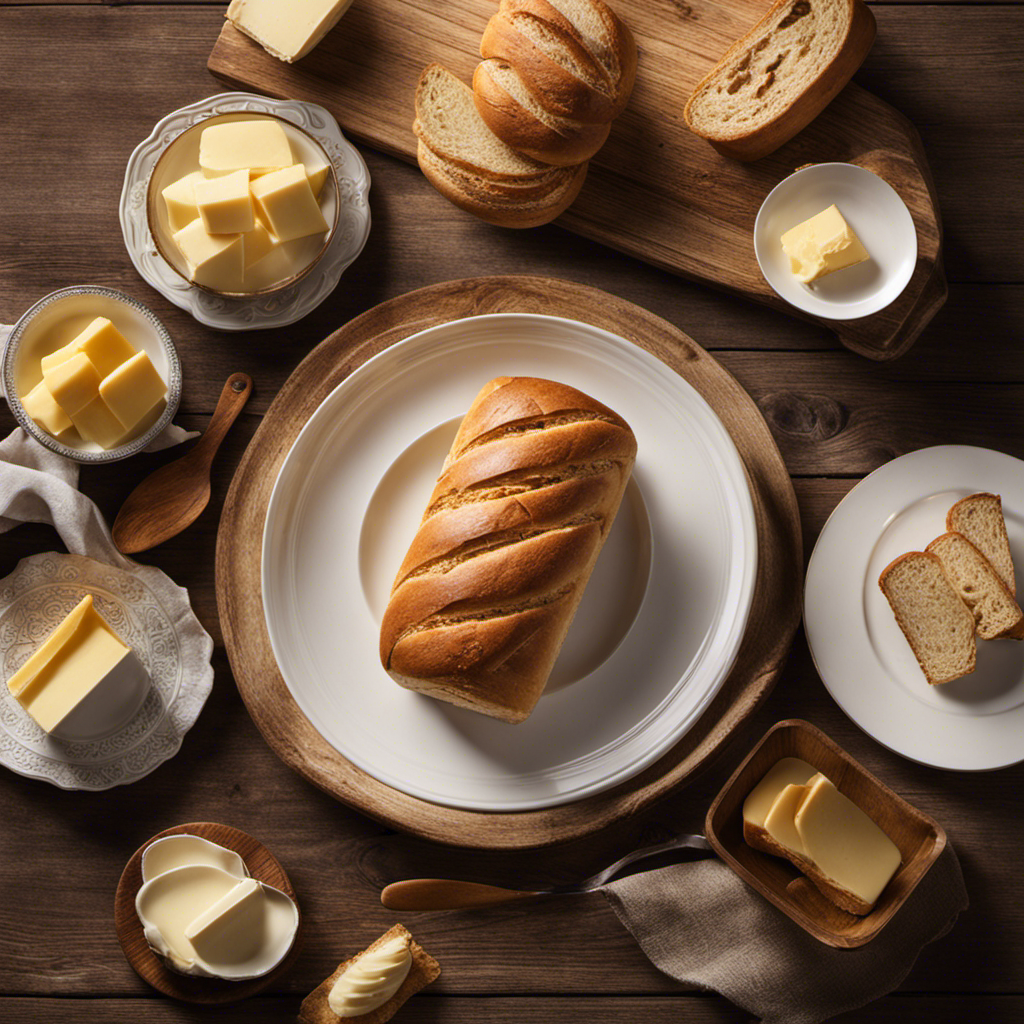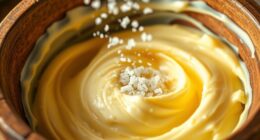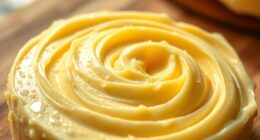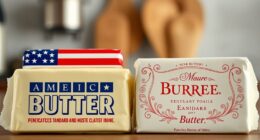I have always had a love for butter. It adds richness and flavor to many dishes. Lately, there has been a lot of talk about vegetable butter. It has piqued my curiosity.
What exactly is plant butter? How is it made? And, most importantly, is it a healthier alternative to dairy butter?
In this article, we’ll explore the world of plant butter, its ingredients, benefits, and how it compares to traditional butter. Let’s dive in and uncover the truth about this trendy spread.
Key Takeaways
- Plant butter is made from plant-based oils and fats, such as coconut, avocado, or olive oil, and is often fortified with essential vitamins and minerals.
- It is a healthier alternative to dairy butter, as it is lower in calories, free from trans fats, and rich in healthy fats that promote heart health.
- Plant butter production has a lower environmental impact, making it a more sustainable choice.
- Plant butter is versatile and can be used in various recipes, providing a rich and flavorful touch to dishes, while also catering to those with dietary restrictions, such as vegans.
What Are the Ingredients in Plant Butter
Plant butter is a dairy-free alternative to traditional butter, made from plant-based oils and fats. The main ingredients in plant butter usually include a combination of oils such as coconut, avocado, or olive oil, along with emulsifiers like sunflower lecithin and natural flavors. These ingredients are carefully selected to mimic the taste and texture of real butter.
Plant butter can be used in various cooking methods, just like regular butter. It can be spread on toast, melted for baking, or used for sautéing vegetables. While the nutritional value of plant butter varies depending on the brand, it generally contains less saturated fat and cholesterol compared to dairy butter. Additionally, some brands fortify their plant butter with vitamins and minerals, making it a healthier option.
How Is Plant Butter Made
The process of making plant butter involves using plant-based oils and emulsifiers to create a creamy and spreadable product. Here’s how it’s done:
-
Selecting the oils: Different plant butter flavors are created by using a variety of oils, such as coconut, avocado, or olive oil. These oils provide the base for the butter and contribute to its taste and texture.
-
Emulsifying the oils: Emulsifiers like lecithin or soy protein isolate are added to the oils to create a stable and smooth consistency. These emulsifiers help bind the water and oil molecules together, preventing separation.
-
Churning and cooling: The emulsified oils are then churned to incorporate air and create a butter-like texture. The mixture is then cooled to solidify it into a spreadable form.
-
Packaging and storage: Once the plant butter is made, it is packaged and stored in the refrigerator to maintain its freshness and prevent spoilage.
Cooking with plant butter is a versatile option as it can be used in various recipes, from baking to sautéing. Its creamy texture and rich flavor make it a great substitute for traditional butter in both sweet and savory dishes.
With the process of making plant butter covered, let’s now explore the health benefits of this plant-based alternative.
The Health Benefits of Plant Butter
You’ll love the health benefits of choosing plant butter as a substitute in your recipes. Plant butter is not only delicious, but it also offers numerous advantages for your well-being. Firstly, plant butter can aid in weight loss due to its lower calorie content compared to dairy butter. It is also rich in healthy fats, which can promote heart health by reducing bad cholesterol levels. Additionally, plant butter is typically free from trans fats, which are known to increase the risk of heart disease. To highlight the health benefits of plant butter, here’s a helpful comparison table:
| Health Benefits of Plant Butter |
|---|
| Weight loss |
| Heart health |
In the next section, we will explore how plant butter compares to dairy butter in terms of taste and nutritional content.
How Does Plant Butter Compare to Dairy Butter
When it comes to the health benefits of plant butter, there are several key points to consider.
Plant butter is typically made from plant-based oils, such as avocado or coconut oil, which are rich in healthy fats and can help improve heart health.
Additionally, plant butter is often free from cholesterol and lactose, making it a suitable option for those with dietary restrictions.
As we delve into the environmental impact comparison, it is important to note that plant butter production generally requires fewer resources and produces fewer greenhouse gas emissions compared to traditional dairy butter production.
Health Benefits of Plant Butter
To experience the health benefits of plant butter, try incorporating it into your daily meals. Here are four reasons why plant butter can be beneficial for your health:
-
Plant butter in skincare: Plant-based butters like shea butter and cocoa butter are commonly used in skincare products due to their moisturizing and nourishing properties. They help hydrate the skin, improve elasticity, and protect against dryness and irritation.
-
Plant butter in weight loss: Unlike dairy butter, plant butter is lower in saturated fat and cholesterol. It can be a healthier alternative for those looking to reduce their calorie intake and manage their weight. Plant butter made from olive oil or avocado oil, for example, contains heart-healthy monounsaturated fats.
-
Rich in nutrients: Plant-based butters are often packed with essential vitamins, minerals, and antioxidants. For instance, almond butter is a good source of vitamin E, while coconut butter contains medium-chain fatty acids that can boost metabolism.
-
Suitable for vegans and lactose intolerant individuals: Plant butter is a great option for those following a vegan or dairy-free diet. It provides a similar creamy texture and flavor to dairy butter but without the animal products.
Incorporating plant butter into your daily meals can offer various health benefits, from improving your skin’s health to supporting weight management. So why not give it a try and enjoy the advantages it brings?
Environmental Impact Comparison
Contrary to popular belief, plant-based alternatives have a lower environmental impact compared to traditional dairy products. When it comes to environmental sustainability, plant-based alternatives, such as plant butter, have a clear advantage.
The production of traditional dairy products involves significant greenhouse gas emissions, land degradation, and water pollution. On the other hand, plant-based alternatives require fewer resources, emit fewer greenhouse gases, and have a smaller ecological footprint.
Additionally, ethical considerations also come into play. Plant-based alternatives do not contribute to animal cruelty, as they do not involve the exploitation of animals for milk production. Transitioning to plant-based alternatives is not only better for the environment, but it also aligns with our ethical values.
Now that we understand the environmental benefits of plant butter, let’s explore the different varieties available.
Different Varieties of Plant Butter
When it comes to plant butter, there are several health benefits that make it an appealing alternative to dairy butter. Not only is plant butter cholesterol-free, but it is also lower in saturated fat, making it a heart-healthy option.
Additionally, plant butter comes in a variety of flavors, from traditional salted to more unique options like garlic and herb or cinnamon sugar. With its versatility and creamy texture, plant butter is not only great for spreading on toast or baking, but it can also be used in cooking to add a rich and flavorful touch to your favorite dishes.
Health Benefits of Plant Butter
You’ll love the health benefits of plant butter, such as being dairy-free and lower in saturated fat. Here are four reasons why plant butter is a great choice for your cooking needs and nutritional value:
-
Heart-healthy fats: Plant butter is made from oils derived from plants like avocados, olives, and nuts. These oils are rich in monounsaturated and polyunsaturated fats, which are known to promote heart health.
-
Vitamin and mineral content: Plant butter is often fortified with essential vitamins and minerals, such as vitamin B12 and vitamin D, which are typically found in animal-based products. This makes plant butter a great option for those following a vegan or plant-based diet.
-
Antioxidants: Many plant-based oils used in plant butter, such as olive oil, are packed with antioxidants. These compounds help protect our cells from damage caused by harmful free radicals.
-
Versatility in cooking: Plant butter can be used in a variety of cooking methods, from sautéing vegetables to baking delicious pastries. Its creamy texture and rich flavor make it a favorite among chefs and home cooks alike.
With its cooking benefits and nutritional value, plant butter is a fantastic alternative for those looking to reduce their consumption of dairy and saturated fat while still enjoying delicious and healthy meals.
Popular Plant Butter Flavors
The most popular flavors of plant butter include garlic and herb, avocado lime, and maple pecan. These flavors add a delicious twist to any dish and make plant butter a versatile ingredient in different cuisines. Whether you’re cooking up a savory pasta dish or baking a sweet treat, there’s a plant butter flavor that will complement your recipe perfectly. To give you a better idea of the variety of plant butter flavors available, here’s a table showcasing some popular plant butter brands and their flavors:
| Brand | Flavors |
|---|---|
| Earth Balance | Garlic and Herb |
| Miyoko’s | Avocado Lime |
| Country Crock | Maple Pecan |
With these flavors, you can experiment and create unique and flavorful dishes that cater to your taste preferences. So why not give plant butter a try and add a burst of flavor to your next culinary creation?
Cooking and Baking With Plant Butter
Cooking and baking with plant-based butter substitutes can provide a healthier option without sacrificing flavor. Here are some cooking tips and recipe ideas to help you make the most of plant butter in your culinary creations:
-
Use plant butter in place of regular butter in your favorite recipes. It can be used in equal amounts, making it a simple substitution.
-
When sautéing vegetables, melt plant butter in the pan for a delicious, buttery flavor. It adds richness without the saturated fats found in traditional butter.
-
Plant butter is great for spreading on toast, muffins, or pancakes. It has a creamy texture and a delicate taste that enhances any breakfast dish.
-
Experiment with different flavors of plant butter, such as garlic and herb or cinnamon. They can add a unique twist to your dishes.
By incorporating plant butter into your cooking and baking, you can enjoy the benefits of a healthier option while still indulging in delicious flavors.
Now, let’s explore whether plant butter is suitable for vegans.
Is Plant Butter Suitable for Vegans
If you’re vegan, plant butter is a suitable option for you. Plant butter is made from plant-based oils, such as avocado or coconut oil, and is free from any animal products. It can be used in cooking and baking just like regular butter, making it a versatile alternative.
When it comes to taste, plant butter can be very similar to traditional butter. Many brands have worked hard to recreate the creamy and rich taste that butter provides. However, it’s important to note that different brands may have slightly different flavors, so it’s worth trying a few to find your favorite.
Overall, plant butter is a great option for vegans who want to enjoy the taste and texture of butter while still adhering to their dietary choices.
Cooking and Baking With Plant Butter
When it comes to cooking and baking with plant butter, there are several key points to consider.
First, plant butter offers a range of health benefits compared to traditional butter, such as being cholesterol-free and lower in saturated fat.
Second, plant butter can be used in a variety of culinary applications, from spreading on toast to incorporating into pastries and sauces.
Lastly, if you’re looking to substitute butter with plant butter, there are some helpful tips to ensure a successful outcome, such as adjusting the amount used and considering the flavor profile of the dish.
Health Benefits of Plant Butter
One of the health benefits of plant butter is that it contains no cholesterol. This makes it a great option for those concerned about their heart health.
In addition, plant butter can also help with weight management. Here are four reasons why:
-
Lower in saturated fat: Plant butter is typically lower in saturated fat compared to traditional dairy butter, which can be beneficial for maintaining a healthy weight.
-
High in unsaturated fats: Plant butter is often made from oils that are high in unsaturated fats, such as olive oil or avocado oil. These fats have been shown to have positive effects on heart health.
-
Rich in essential nutrients: Plant butter can provide essential nutrients, such as vitamin E and omega-3 fatty acids, which are important for overall well-being.
-
Plant-based ingredients: Plant butter is made from plant-based ingredients, making it suitable for those following a vegan or plant-based diet.
Overall, incorporating plant butter into your diet can have positive effects on both heart health and weight management.
In the next section, we will explore the culinary uses of plant butter.
Culinary Uses of Plant Butter
To enhance your culinary creations, try incorporating plant butter into your favorite recipes. Plant butter is a versatile and delicious alternative to traditional dairy butter, and it can be used in a variety of ways in the kitchen. Whether you’re baking, sautéing, or spreading it on toast, plant butter adds a rich and creamy flavor to any dish.
Here are some plant butter recipes that you can try:
| Recipe | Ingredients |
|---|---|
| Vegan Chocolate Chip Cookies | Plant butter, flour, sugar, chocolate chips |
| Creamy Garlic Mashed Potatoes | Potatoes, plant butter, garlic, salt, pepper |
| Vegan Grilled Cheese Sandwich | Bread, plant butter, vegan cheese |
Plant butter alternatives, such as almond butter or coconut oil, can also be used in these recipes for a different flavor profile. So why not give plant butter a try and elevate your cooking to new heights?
Tips for Substituting Butter
When it comes to substituting butter in baking, there are a few tips I’ve learned along the way. Here are four helpful suggestions to make the transition to plant-based fats easier and ensure delicious results:
-
Measure accurately: Use the same amount of plant butter as you would regular butter to maintain the recipe’s balance.
-
Choose the right plant butter: Look for plant-based spreads that are specifically formulated for baking. These spreads have a similar texture and flavor to regular butter, making them a seamless substitute.
-
Adjust baking time and temperature: Plant-based fats have a lower melting point than butter, so you may need to lower the oven temperature slightly and reduce baking time to prevent overbrowning.
-
Enjoy the health benefits: Plant-based fats, such as those found in plant butter, are rich in monounsaturated and polyunsaturated fats, which can help lower bad cholesterol levels and reduce the risk of heart disease.
With these tips in mind, you can confidently bake using plant butter and reap the health benefits of plant-based fats.
Can Plant Butter Be Used as a Spread
Absolutely! Plant butter, made from plant-based oils like coconut or avocado, can be a delicious and nutritious alternative to dairy butter. In terms of nutritional value, plant butter typically has less saturated fat and cholesterol compared to dairy butter. It is also a good source of healthy fats, such as monounsaturated and polyunsaturated fats.
To incorporate plant butter into your daily diet, simply spread it on your toast or crackers just like you would with regular butter. You can also use it in baking, cooking, or as a topping for steamed vegetables. So go ahead and enjoy the creamy goodness of plant butter guilt-free!
Now, let’s explore the differences between plant butter and margarine.
Plant Butter Vs Margarine: What’s the Difference
There are several key distinctions between plant butter and margarine.
-
Ingredients: Plant butter is typically made from plant-based oils, such as coconut oil or avocado oil. Margarine, on the other hand, is made from vegetable oils that have been hydrogenated to solidify them.
-
Healthiness: Plant butter alternatives are often seen as a healthier choice compared to margarine. This is because they are free from trans fats, which have been linked to various health issues.
-
Nutritional Content: Plant butter alternatives tend to be higher in monounsaturated fats and lower in saturated fats compared to margarine. They also contain essential fatty acids, such as omega-3 and omega-6.
-
Taste and Texture: Some people prefer the taste and texture of plant butter alternatives, as they can mimic the creamy and rich consistency of traditional dairy butter.
Plant Butter and Cholesterol: What You Need to Know
If you’re looking to manage your cholesterol levels, it’s important to know the impact of using plant-based alternatives instead of traditional dairy butter.
Plant butter can be a great option for heart health and weight loss. Unlike dairy butter, which is high in saturated fat and cholesterol, plant butter is made from plant-based oils and contains no cholesterol. This can help to lower your LDL (bad) cholesterol levels and reduce the risk of heart disease.
Additionally, plant butter is lower in calories than dairy butter, making it a healthier choice for those looking to lose weight.
By incorporating plant butter into your diet, you can enjoy the delicious taste of butter while also taking care of your heart and waistline.
Where Can You Buy Plant Butter?
After learning about the benefits of plant butter for cooking and its impact on cholesterol levels, you might be wondering where you can find this healthy alternative. Luckily, plant butter is becoming increasingly popular and can be found in various places.
Here are four common sources for purchasing plant butter:
-
Grocery stores: Many supermarkets now carry plant butter in their refrigerated section, usually near the regular butter or dairy alternatives.
-
Health food stores: Specialty health food stores often have a wide selection of plant-based products, including different brands and varieties of plant butter.
-
Online retailers: Several online retailers offer plant butter for purchase, providing convenience and access to a broader range of options.
-
Farmer’s markets: Some local farmer’s markets may have vendors who produce and sell homemade plant butter.
Using plant butter in your cooking can provide numerous benefits, such as reducing saturated fat intake, lowering cholesterol levels, and supporting a more sustainable food system. So, don’t hesitate to explore these sources and incorporate plant butter into your culinary adventures.
Frequently Asked Questions
Can Plant Butter Be Used as a Substitute for Dairy Butter in All Recipes?
Yes, plant butter can be used as a substitute for dairy butter in most recipes. It offers the benefits of being a plant-based alternative, which can be healthier, lower in saturated fat, and suitable for those with lactose intolerance or dietary restrictions.
What Are the Environmental Benefits of Using Plant Butter Instead of Dairy Butter?
Using plant butter instead of dairy butter has environmental benefits. It reduces the carbon footprint, promotes sustainable agriculture, and conserves water resources. These factors make plant butter a more environmentally friendly choice.
Is Plant Butter Suitable for Individuals With Lactose Intolerance?
Yes, plant butter is suitable for individuals with lactose intolerance. It is a dairy alternative made from plant-based oils, which means it does not contain lactose. It is a great option for those who cannot consume dairy products.
Are There Any Potential Allergens in Plant Butter?
In plant butter, there may be potential allergens to consider. It’s important to read labels and check for any allergenic ingredients. If concerned, there are alternative options for dairy butter substitutes that may be suitable.
Can Plant Butter Be Used in the Same Way as Dairy Butter for Sautéing and Frying?
Yes, plant butter can be used in the same way as dairy butter for sautéing and frying. It has a similar consistency and flavor. However, it may not work as well for baking and may not spread as easily on bread.
Conclusion
After learning about the ingredients, making process, health benefits, and comparisons to dairy butter and margarine, I am convinced that plant butter is a fantastic alternative.
It is not only delicious and versatile, but it also offers a healthier option for those concerned about cholesterol and saturated fats.
Knowing that plant butter can be easily found in local grocery stores makes it even more convenient to incorporate into our daily lives.
So why not give it a try and experience the deliciousness and benefits of plant butter for yourself?
